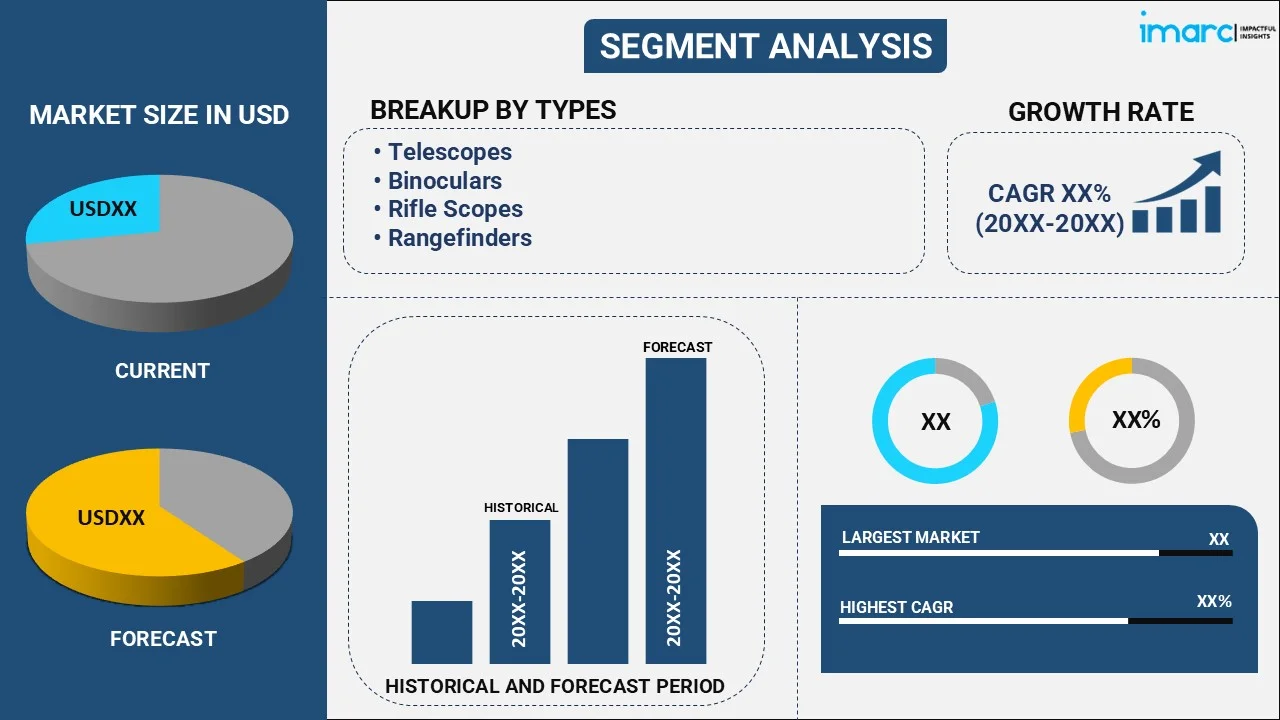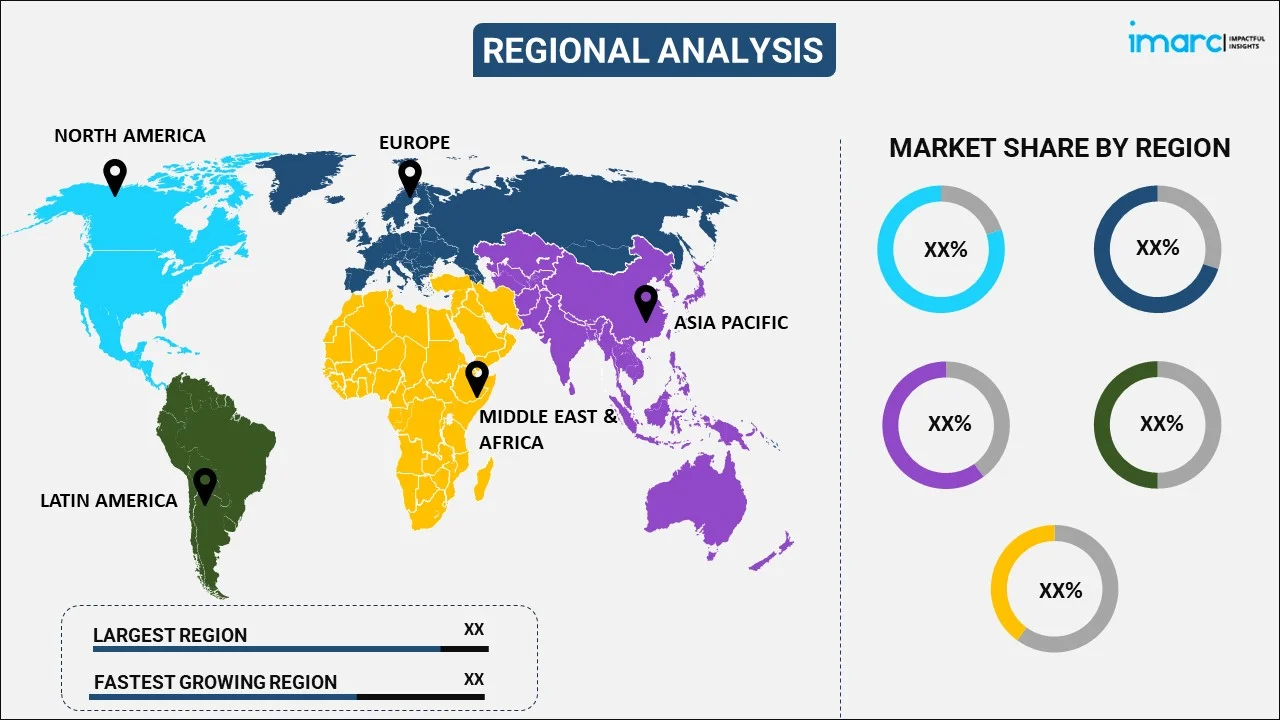
Sports Optic Market Report by Type (Telescopes, Binoculars, Rifle Scopes, Rangefinders), Distribution Channel (Online, Offline), Application (Shooting Sports, Golf, Water Sports, Wheel Sports, Snow Sports, Horse Racing, and Others), and Region 2025-2033
Global Sports Optic Market:
The global sports optic market size reached USD 2.32 Billion in 2024. Looking forward, IMARC Group expects the market to reach USD 2.90 Billion by 2033, exhibiting a growth rate (CAGR) of 2.5% during 2025-2033. The growing outdoor recreational activities, along with the increasing brand influence, are bolstering the market.
|
Report Attribute
|
Key Statistics
|
|---|---|
|
Base Year
|
2024
|
|
Forecast Years
|
2025-2033
|
|
Historical Years
|
2019-2024
|
|
Market Size in 2024
|
USD 2.32 Billion |
|
Market Forecast in 2033
|
USD 2.90 Billion |
| Market Growth Rate 2025-2033 | 2.5% |
Sports Optic Market Analysis:
- Major Market Drivers: The rising consumer interest in outdoor and sporting activities is one of the key factors bolstering the market. Moreover, the increasing number of recreational activities is also acting as another significant growth-inducing factor.
- Key Market Trends: The growing integration of smart technology in sports optics, such as global positioning systems (GPS) in binoculars or ballistic calculators in riflescopes, is fueling the market.
- Competitive Landscape: Some of the prominent companies in the global market include American Technologies Network Corp, Burris Company Inc., Bushnell Inc. (Vista Outdoor Inc.), Carl Zeiss AG, Celestron LLC (Synta Technology Corporation of Taiwan), Karl Kaps GmbH & Co. KG, Leica Camera Aktiengesellschaft, Leupold & Stevens Inc., Meopta - optika s.r.o, Nikon Corporation, Primary Arms L.L.C., Teledyne Flir LLC (Teledyne Technologies Incorporated), and Trijicon Inc., among many others.
- Geographical Trends: North America exhibits a clear dominance in the market, owing to substantial spending on sports equipment. Furthermore, the growing presence of international brands is also contributing to the market.
- Challenges and Opportunities: One of the limitations hindering the market is the high cost of advanced technology. However, extensive investments in R&D activities to create more affordable sports products are expected to fuel the market in the coming years.
Sports Optic Market Trends:
Rising Adoption of Digital Technology
The growing incorporation of features, including high-definition video recording, digital image stabilization, smartphone integration, etc., is acting as a significant growth-inducing factor. For example, in April 2024, FORM, the industry-leading fitness technology company pioneering real-time visual feedback to elevate athletic performance, launched its second-generation augmented reality swim goggles that cater to both triathletes and swimmers of all abilities. Apart from this, products such as ATN and Pulsar are equipped with these advanced features, which is escalating the sports optic market demand.
Growing Popularity of Outdoor Activities
The escalating demand for high-quality optics, including spotting scopes and binoculars, is propelling the market. This trend is also bolstered by the inflating inclination towards nature and wildlife observation as a safe and relaxing outdoor activity. For example, in January 2024, Ricoh Imaging Americas Corporation unveiled the PENTAX PF-85EDA spotting scope that is ideal for a variety of applications, including birdwatching and nature and astronomical observations. Apart from this, companies like Zeiss and Vortex have seen increased sales of birdwatching optics, which is positively influencing the sports optic market outlook.
Expansion of B2B Platforms
B2B platforms provide a centralized hub where businesses can source a wide range of optics directly from producers like Nikon, Vortex, and Bushnell. By leveraging B2B platforms, companies can access bulk purchasing options, competitive pricing, and detailed product specifications, which aids in inventory management and strategic planning. Furthermore, platforms like Global Sources and Alibaba offer networking opportunities and market insights, thereby enabling businesses to stay updated with industry trends and innovations. Besides this, in March 2024, Zenni Optical launched a B2B platform that includes manufacturing and logistics, ownership of optical laboratories, frame design, etc.
Global Sports Optic Industry Segmentation:
IMARC Group provides an analysis of the key trends in each segment of the market, along with the sports optic market forecast at the global, regional, and country levels for 2025-2033. Our report has categorized the market based on the type, distribution channel, and application.
Breakup by Type:

- Telescopes
- Binoculars
- Rifle Scopes
- Rangefinders
Telescopes currently exhibit a clear dominance in the market
The report has provided a detailed breakup and analysis of the market based on the type. This includes telescopes, binoculars, rifle scopes, and rangefinders. According to the report, telescopes represented the largest market segmentation.
Telescopes represent the largest segment of the market due to their diverse applications and widespread popularity among various user groups, from amateur astronomers to professional researchers. These instruments offer the capability to observe distant objects with remarkable clarity, making them indispensable for activities such as stargazing, wildlife observation, and even maritime navigation. For instance, brands like Celestron and Meade have developed telescopes that cater to different skill levels, from beginner-friendly models to advanced systems with computerized mounts for precise tracking, which is elevating the sports optic market's recent price across this segmentation.
Breakup by Distribution Channel:
- Online
- Offline
Currently, online holds the largest market share
The report has provided a detailed breakup and analysis of the market based on the distribution channel. This includes online and offline. According to the report, online represented the largest market segmentation.
Online sales represent the largest segment in the market due to the convenience, extensive product range, and competitive pricing that e-commerce platforms offer. Customers can easily compare different brands and models, read reviews, and access detailed specifications, thereby making informed decisions without the need to visit physical stores. For example, platforms like Amazon and B&H Photo provide a vast selection of sports optics, from binoculars and telescopes to spotting scopes, which is augmenting the sports optic market revenue across the segmentation.
Breakup by Application:
- Shooting Sports
- Golf
- Water Sports
- Wheel Sports
- Snow Sports
- Horse Racing
- Others
Shooting sports account for the majority of the total sports optic market share
The report has provided a detailed breakup and analysis of the market based on the application. This includes shooting sports, golf, water sports, wheel sports, snow sports, horse racing, and others. According to the report, shooting sports represented the largest market segmentation.
Shooting sports represent the largest segment in the market due to the critical role optics play in enhancing accuracy and performance. Shooters, whether involved in hunting, competitive shooting, or recreational target practice, rely heavily on high-quality optics such as riflescopes, red dot sights, and rangefinders to improve their precision and overall experience. For example, brands like Vortex Optics and Leupold have developed specialized products tailored to the unique needs of shooters, offering features, such as long-range capabilities, advanced reticle systems, and rugged durability to withstand harsh conditions. This, in turn, is elevating the sports optic market statistics.
Breakup by Region:

- North America
- United States
- Canada
- Asia-Pacific
- China
- Japan
- India
- South Korea
- Australia
- Indonesia
- Others
- Europe
- Germany
- France
- United Kingdom
- Italy
- Spain
- Russia
- Others
- Latin America
- Brazil
- Mexico
- Others
- Middle East and Africa
North America currently dominates the market
The market research report has also provided a comprehensive analysis of all the major regional markets, which include North America (the United States and Canada); Asia Pacific (China, Japan, India, South Korea, Australia, Indonesia, and others); Europe (Germany, France, the United Kingdom, Italy, Spain, Russia, and others); Latin America (Brazil, Mexico, and others); and the Middle East and Africa. According to the report, North America accounted for the largest market share.
As per the sports optic market overview, North America is thriving, driven by a robust interest in outdoor activities such as birdwatching, hunting, and stargazing. The region's diverse landscapes, from vast forests and mountain ranges to open prairies and coastal areas, create ideal conditions for using high-quality optics. For instance, American brands like Bushnell and Leupold have become industry leaders by offering a wide range of products, including binoculars, spotting scopes, and riflescopes, designed to meet the specific needs of North American consumers. Additionally, the popularity of amateur astronomy in the United States has spurred demand for advanced telescopes from companies like Celestron.
Competitive Landscape:
At present, key players in the sports optics market are actively engaging in various strategic initiatives to enhance their market presence and cater to the rising demand for high-quality optical solutions. They are heavily investing in research and development (R&D) to introduce innovative products with advanced features like improved clarity, range, and durability, suitable for various sports and outdoor activities. Moreover, collaborations, mergers, and acquisitions are also prominent strategies these companies adopt to expand their global footprint and product portfolio. This represents one of the sports optic market recent opportunities. Furthermore, they focus on strengthening their distribution networks and enhancing customer engagement through digital marketing and e-commerce platforms.
The market research report has provided a comprehensive analysis of the competitive landscape. Detailed profiles of all major sports optic market companies have also been provided. Some of the key players in the market include:
- American Technologies Network Corp
- Burris Company Inc.
- Bushnell Inc. (Vista Outdoor Inc.)
- Carl Zeiss AG
- Celestron LLC (Synta Technology Corporation of Taiwan)
- Karl Kaps GmbH & Co. KG
- Leica Camera Aktiengesellschaft
- Leupold & Stevens Inc.
- Meopta - optika s.r.o
- Nikon Corporation
- Primary Arms L.L.C.
- Teledyne Flir LLC (Teledyne Technologies Incorporated)
- Trijicon Inc.
(Please note that this is only a partial list of the key players, and the complete list is provided in the report.)
Sports Optic Market Recent Developments:
- July 2024: Zenni Optical partnered with USA Volleyball (USAV) to launch an innovative line of sports optic sunglasses.
- May 2024: One of the opticians and eyewear retail chains, Optic 2000, collaborated with Artha to empower visually impaired gamers.
- February 2024: Italian football club Juventus announced the introduction of a capsule collection with OpTic Gaming for sports and esports.
Sports Optic Market Report Scope:
| Report Features | Details |
|---|---|
| Base Year of the Analysis | 2024 |
| Historical Period | 2019-2024 |
| Forecast Period | 2025-2033 |
| Units | Billion USD |
| Scope of the Report | Exploration of Historical Trends and Market Outlook, Industry Catalysts and Challenges, Segment-Wise Historical and Predictive Market Assessment:
|
| Types Covered | Telescopes, Binoculars, Rifle Scopes, Rangefinders |
| Distribution Channels Covered | Online, Offline |
| Applications Covered | Shooting Sports, Golf, Water Sports, Wheel Sports, Snow Sports, Horse Racing, Others |
| Regions Covered | Asia Pacific, Europe, North America, Latin America, Middle East and Africa |
| Countries Covered | United States, Canada, Germany, France, United Kingdom, Italy, Spain, Russia, China, Japan, India, South Korea, Australia, Indonesia, Brazil, Mexico |
| Companies Covered | American Technologies Network Corp, Burris Company Inc., Bushnell Inc. (Vista Outdoor Inc.), Carl Zeiss AG, Celestron LLC (Synta Technology Corporation of Taiwan), Karl Kaps GmbH & Co. KG, Leica Camera Aktiengesellschaft, Leupold & Stevens Inc., Meopta - optika s.r.o, Nikon Corporation, Primary Arms L.L.C., Teledyne Flir LLC (Teledyne Technologies Incorporated), Trijicon Inc., etc. |
| Customization Scope | 10% Free Customization |
| Post-Sale Analyst Support | 10-12 Weeks |
| Delivery Format | PDF and Excel through Email (We can also provide the editable version of the report in PPT/Word format on special request) |
Key Benefits for Stakeholders:
- IMARC's industry report offers a comprehensive quantitative analysis of various market segments, historical and current market trends, market forecasts, and dynamics of the sports optic market from 2019-2033.
- The research report provides the latest information on the market drivers, challenges, and opportunities in the global sports optic market.
- The study maps the leading, as well as the fastest-growing, regional markets. It further enables stakeholders to identify the key country-level markets within each region.
- Porter's five forces analysis assists stakeholders in assessing the impact of new entrants, competitive rivalry, supplier power, buyer power, and the threat of substitution. It helps stakeholders to analyze the level of competition within the sports optic industry and its attractiveness.
- The competitive landscape allows stakeholders to understand their competitive environment and provides insight into the current positions of key players in the market.
Key Questions Answered in This Report
The global sports optic market was valued at USD 2.32 Billion in 2024.
We expect the global sports optic market to exhibit a CAGR of 2.5% during 2025-2033.
The increasing popularity of recreational and sports activities, along with the rising utilization of sports optic devices for magnifying distant objects for improved clarity and enhanced performance, is primarily driving the global sports optic market growth.
The sudden outbreak of the COVID-19 pandemic has led to limited demand for sports optic devices due to temporary restrictions on outdoor sports activities. However, in the post-COVID-19 scenario, there is anticipated to be an increased demand for sports optic devices among health-conscious consumers, owing to the growing inclination towards various sports activities.
Based on the type, the global sports optic market can be segmented into telescopes, binoculars, rifle scopes, and rangefinders. Among these, telescopes currently hold the majority of the total market share.
Based on the distribution channel, the global sports optic market has been divided into online and offline. Currently, online exhibits a clear dominance in the market.
Based on the application, the global sports optic market can be categorized into shooting sports, golf, water sports, wheel sports, snow sports, horse racing, and others. Among these, shooting sports account for the largest market share.
On a regional level, the market has been classified into North America, Asia-Pacific, Europe, Latin America, and Middle East and Africa, where North America currently dominates the global market.
Some of the major players in the global sports optic market include American Technologies Network Corp, Burris Company Inc., Bushnell Inc. (Vista Outdoor Inc.), Carl Zeiss AG, Celestron LLC (Synta Technology Corporation of Taiwan), Karl Kaps GmbH & Co. KG, Leica Camera Aktiengesellschaft, Leupold & Stevens Inc., Meopta - optika s.r.o, Nikon Corporation, Primary Arms L.L.C., Teledyne Flir LLC (Teledyne Technologies Incorporated), and Trijicon Inc.
Need more help?
- Speak to our experienced analysts for insights on the current market scenarios.
- Include additional segments and countries to customize the report as per your requirement.
- Gain an unparalleled competitive advantage in your domain by understanding how to utilize the report and positively impacting your operations and revenue.
- For further assistance, please connect with our analysts.

 Inquire Before Buying
Inquire Before Buying
 Speak to an Analyst
Speak to an Analyst
 Request Brochure
Request Brochure
 Request Customization
Request Customization




.webp)




.webp)












